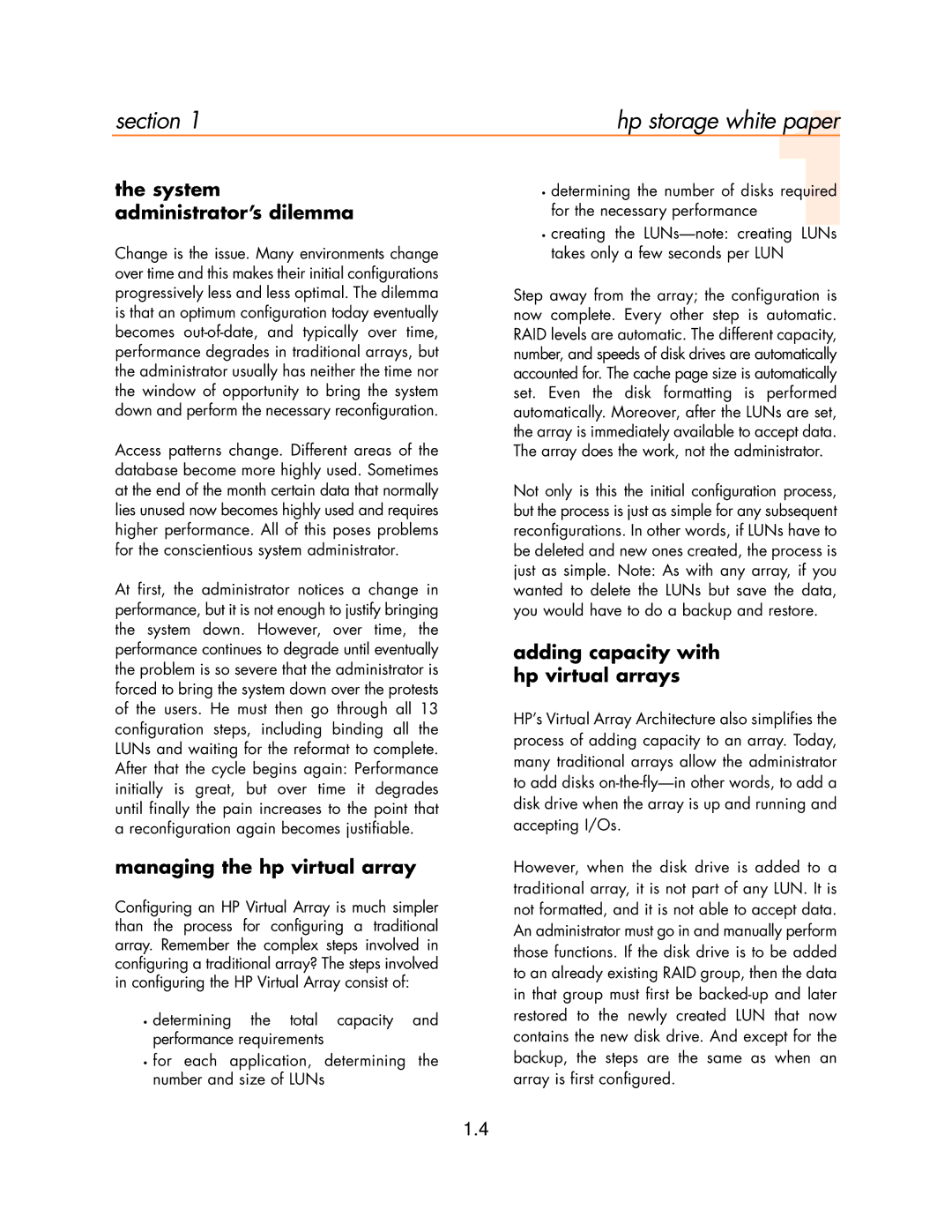section 1 |
|
|
| hp storage white paper |
| |
the system |
|
|
| • determining the number of disks required | ||
administrator’s dilemma |
| for the necessary performance | ||||
|
|
|
| • creating the | ||
Change is the issue. Many environments change | takes only a few seconds per LUN1 | |||||
over time and this makes their initial configurations |
|
| ||||
progressively less and less optimal. The dilemma | Step away from the array; the configuration is | |||||
is that an optimum configuration today eventually | now complete. Every other step is automatic. | |||||
becomes | RAID levels are automatic. The different capacity, | |||||
performance degrades in traditional arrays, but | number, and speeds of disk drives are automatically | |||||
the administrator usually has neither the time nor | accounted for. The cache page size is automatically | |||||
the window of opportunity to bring the system | set. Even the disk formatting is performed | |||||
down and perform the necessary reconfiguration. | automatically. Moreover, after the LUNs are set, | |||||
Access patterns change. Different areas of the | the array is immediately available to accept data. | |||||
The array does the work, not the administrator. | ||||||
database become more highly used. Sometimes |
|
| ||||
at the end of the month certain data that normally | Not only is this the initial configuration process, | |||||
lies unused now becomes highly used and requires | but the process is just as simple for any subsequent | |||||
higher performance. All of this poses problems | reconfigurations. In other words, if LUNs have to | |||||
for the conscientious system administrator. |
| be deleted and new ones created, the process is | ||||
At first, the administrator notices a change in | just as simple. Note: As with any array, if you | |||||
wanted to delete the LUNs but save the data, | ||||||
performance, but it is not enough to justify bringing | you would have to do a backup and restore. | |||||
the system down. However, over time, the |
|
| ||||
performance continues to degrade until eventually | adding capacity with | |||||
the problem is so severe that the administrator is | hp virtual arrays | |||||
forced to bring the system down over the protests |
|
| ||||
of the users. He must then go through all 13 | HP’s Virtual Array Architecture also simplifies the | |||||
configuration steps, including | binding all | the | ||||
process of adding capacity to an array. Today, | ||||||
LUNs and waiting for the reformat to complete. | ||||||
many traditional arrays allow the administrator | ||||||
After that the cycle begins again: Performance | ||||||
to add disks | ||||||
initially is great, | but over time it degrades | |||||
disk drive when the array is up and running and | ||||||
until finally the pain increases to the point that | ||||||
a reconfiguration again becomes justifiable. | accepting I/Os. | |||||
managing the hp virtual array | However, when the disk drive is added to a | |||||
Configuring an HP Virtual Array is much simpler | traditional array, it is not part of any LUN. It is | |||||
not formatted, and it is not able to accept data. | ||||||
than the process for configuring a traditional | An administrator must go in and manually perform | |||||
array. Remember the complex steps involved in | those functions. If the disk drive is to be added | |||||
configuring a traditional array? The steps involved | ||||||
to an already existing RAID group, then the data | ||||||
in configuring the HP Virtual Array consist of: |
| |||||
| in that group must first be | |||||
|
|
|
| |||
• determining | the total | capacity | and | restored to the newly created LUN that now | ||
performance requirements |
|
| contains the new disk drive. And except for the | |||
• for each application, | determining | the | backup, the steps are the same as when an | |||
number and size of LUNs |
| array is first configured. | ||||
1.4
